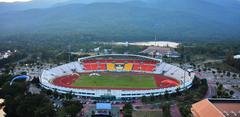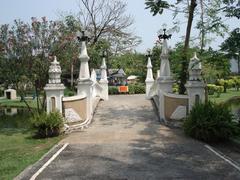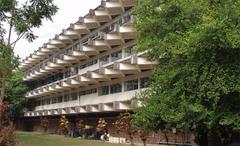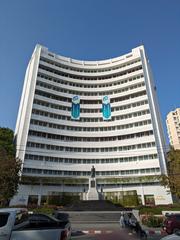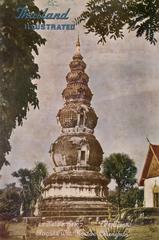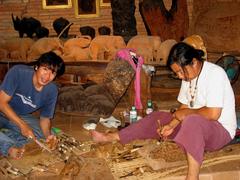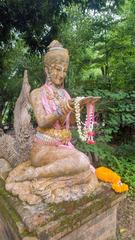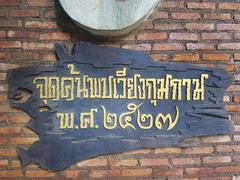North Chiang Mai University Visiting Hours, Tickets, and Historical Sites Guide
Date: 14/06/2025
Introduction: Chiang Mai’s Cultural and Historical Landscape
Nestled in the mountainous region of northern Thailand, Chiang Mai is celebrated for its rich tapestry of cultural heritage, ancient landmarks, and vibrant local traditions. Among its many treasures, North Chiang Mai University (NCU) is not just an educational institution but a living testament to Lanna heritage and the region’s commitment to academic and cultural excellence. The university’s monument, alongside legendary sites like Wat Phra That Doi Suthep and Wat Umong, invites travelers to encounter the intersection of education, spirituality, and history in northern Thailand (North Chiang Mai University).
This comprehensive guide provides essential information for visiting these significant sites, including opening hours, ticketing, travel tips, accessibility, and highlights. Whether you are a history enthusiast, cultural explorer, or first-time visitor, this article will help you navigate Chiang Mai’s iconic monuments and craft a rewarding itinerary.
Contents
- North Chiang Mai University Monument: Cultural Heritage and Visitor Guide
- Historical Significance
- Opening Hours and Ticket Details
- Getting There and Accessibility
- On-Site Points of Interest
- Visitor Amenities and Etiquette
- Nearby Attractions
- Wat Phra That Doi Suthep: Chiang Mai’s Spiritual Summit
- History and Significance
- Visiting Information
- Access and Highlights
- Travel Tips
- Nearby Sites
- Wat Umong: The Tranquil Tunnel Temple
- Historical Context
- Visitor Information
- Highlights and Integration with Other Attractions
- Practical Tips
- Practical Travel Tips & FAQs
- Summary & Further Exploration
- Sources
North Chiang Mai University Monument: Cultural Heritage and Visitor Guide
Historical Significance
The North Chiang Mai University Monument was established in 1999 to honor the founding of NCU and its ongoing contribution to regional education and culture. Situated in Hang Dong district, the monument reflects the spirit of the Lanna Kingdom, symbolizing wisdom, virtue, and service. It is a focal point for both students and visitors, embodying the university’s role in fostering local heritage and community growth (Discovering the North Chiang Mai University Monument).
Opening Hours and Ticket Details
- Hours: Open daily, 8:00 AM – 6:00 PM
- Admission: Free for all visitors
- Guided Tours: Available on weekends at 10:00 AM and 2:00 PM. Advance booking via the university visitor center is recommended.
Getting There and Accessibility
The monument is approximately 15 kilometers southwest of Chiang Mai’s city center. Visitors can reach the site by car, taxi, or local songthaew (shared red trucks). Well-marked signs along major roads point to the campus entrance. The site is fully wheelchair-accessible, ensuring ease of access for all guests.
On-Site Points of Interest
- Monument Plaza: Showcasing Lanna architectural motifs, ideal for photography and quiet reflection.
- Cultural Exhibits: Displays of northern Thai art and university-led community projects.
- Gardens: Landscaped areas for relaxation and informal picnics.
Visitor Amenities and Etiquette
- Wheelchair-accessible pathways and restrooms are available.
- Shaded seating and campus cafeterias offer refreshments and local cuisine.
- Modest attire is required, and photography is permitted except where signage indicates otherwise.
- Engage respectfully with students and staff.
Nearby Attractions
- Hang Dong Handicraft Villages: Experience traditional crafts and local markets.
- Chiang Mai City: Reach the Old Town, Wat Phra That Doi Suthep, and bustling night markets within a short drive.
Digital Resources
Explore a virtual tour and photo gallery on the official NCU website, with images tagged for accessibility (e.g., “North Chiang Mai University Monument”).
Wat Phra That Doi Suthep: Chiang Mai’s Spiritual Summit
History and Significance
Founded in 1383, Wat Phra That Doi Suthep is a revered Buddhist temple perched atop Doi Suthep mountain. The temple enshrines a sacred relic of the Buddha, making it an important pilgrimage destination and a symbol of Lanna culture. Its golden chedi and panoramic city views make it a must-see landmark (Visiting Wat Phra That Doi Suthep).
Visiting Information
- Hours: Daily, 6:00 AM – 6:00 PM
- Tickets: 50 THB for foreign visitors; free for Thai nationals. Small additional fees for parking and photography permits.
- Special Events: Major Buddhist festivals like Visakha Bucha Day and Loy Krathong feature unique ceremonies and lantern releases.
Access and Highlights
- Transportation: Reachable by songthaew (shared red truck), taxi, rental car, or motorbike from Chiang Mai city (approx. 15 km).
- Accessibility: Over 300 naga-flanked steps lead to the temple; a cable car is available for those with mobility needs.
- Highlights:
- Golden chedi (stupa)
- City and mountain viewpoints
- Intricate murals and statues
- Opportunities to receive monk blessings
Travel Tips
- Dress respectfully (shoulders and knees covered).
- Visit early or late in the day for cooler temperatures and fewer crowds.
- Be mindful of temple customs and photography restrictions.
Nearby Sites
- Bhuping Palace: Royal winter residence nearby.
- Doi Suthep-Pui National Park: Hiking, waterfalls, and nature walks.
- Old City: Temples, markets, and cultural attractions easily accessible after your temple visit.
Wat Umong: The Tranquil Tunnel Temple
Historical Context
Wat Umong, dating to 1297, is one of Chiang Mai’s oldest and most unique temples. Its network of ancient tunnels was designed for monastic meditation and teaching. The temple grounds feature traditional architecture, large Buddha statues, and peaceful ponds, offering a glimpse into Lanna Buddhist traditions and spiritual life (Visiting Wat Umong).
Visitor Information
- Location: 8 km southwest of Old City, at the foothills of Doi Suthep.
- Hours: Daily, 6:00 AM – 6:00 PM
- Admission: 20 THB for foreign visitors; free or reduced for Thai nationals and residents.
- Accessibility: Main grounds are accessible, though tunnel areas may have limited access for wheelchair users.
- Guided Tours: Available via local operators; occasional meditation retreats and cultural events are open to the public.
Highlights and Integration with Other Attractions
- Explore cool, mural-adorned tunnels and serene gardens.
- Photograph large Buddha statues and tranquil ponds.
- Combine your visit with nearby sites such as Doi Suthep-Pui National Park, Royal Park Rajapruek (botanical gardens), or Nimmanhaemin Road for cafes and nightlife.
Practical Tips
- November–February is ideal for comfortable weather.
- Modest attire is required.
- Photography is allowed in most outdoor areas; avoid flash inside tunnels.
- Basic facilities (restrooms, snack stalls) are on-site.
- Walk carefully on uneven paths and within tunnels.
Practical Travel Tips & FAQs
Getting Around Chiang Mai
- Transport: Chiang Mai is accessible by air, train, and bus. Within the city, use tuk-tuks, songthaews, taxis, or rent bicycles/motorbikes.
Accessibility
- Major monuments offer ramps and accessible pathways.
- Some sites (like certain temple areas) involve stairs; check in advance if you need special assistance.
Guided Tours & Events
- Guided tours are available at most sites and through local agencies.
- Annual events like the Yi Peng Lantern Festival provide a unique cultural experience.
Frequently Asked Questions
Q: Are there entrance fees for children?
A: Children under 12 usually enter for free or at a discounted rate. Check individual site policies.
Q: Is photography allowed in temples?
A: Generally yes in outdoor and most indoor areas, but respect posted restrictions, especially in sacred spaces.
Q: When is the best time to visit Chiang Mai’s monuments?
A: November to February for cool weather and vibrant festivals.
Summary & Further Exploration
Visiting Chiang Mai’s monuments—including the North Chiang Mai University Monument, Wat Phra That Doi Suthep, and Wat Umong—offers a profound journey through the region’s educational, spiritual, and cultural heritage. These sites are thoughtfully equipped with amenities, guided experiences, and accessible features, ensuring an inclusive and meaningful visit for all. Nearby attractions such as markets, parks, and museums allow travelers to craft a diverse and memorable itinerary.
For updated details, virtual tours, and interactive guides, consult official university and temple websites. Travel apps like Audiala can enhance your planning and on-site experience. Engaging with Chiang Mai’s monuments is more than sightseeing—it is an immersion into the enduring spirit and legacy of northern Thailand.
Begin your journey today and deepen your understanding of Chiang Mai’s history and culture by visiting these remarkable sites (North Chiang Mai University, Wat Phra That Doi Suthep, Wat Umong).
Sources and Further Reading
- Discovering the North Chiang Mai University Monument: A Historical and Cultural Landmark Guide, 2025, North Chiang Mai University (https://www.ncu.ac.th/)
- Visiting Wat Phra That Doi Suthep: Chiang Mai’s Iconic Monument Experience, 2025, Wat Phra That Doi Suthep Official (https://www.doisuthep.com)
- Visiting Wat Umong: A Historic Chiang Mai Monument Guide, 2025, Chiang Mai Tourism (https://www.chiangmaitourismthailand.com/)
